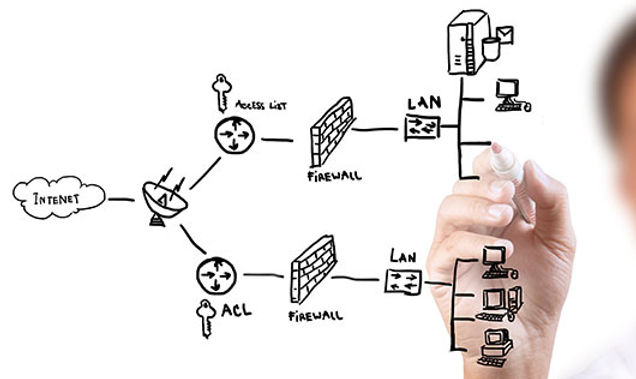- BTI Group
- IT Products Services Articles
- 9 min read
Understanding Network Optimization to Boost Business Performance
Is your business grappling with slow network speeds, rising costs, or frequent bottlenecks? If so, you’re not alone. Many of our new customers initially approached us due to dissatisfaction with their network.After countless vendors, systems, and failed strategies to boost network performance, a good performing network seemed like something impossible for some of them. But why settle for less when having world-class network speeds and performance possible with the right approach?
Network optimization addresses these challenges head-on, paving the way for smoother operations, enhanced security, and increased profitability.Discover the strategies that will allow you to experience unmatched network speeds, increased security, incredible performance, and say goodbye to bottlenecks once and for all by reading this blog!

What is Network Optimization?
Network optimization is the process of utilizing the right tools and techniques to identify and eliminate network issues and as a result, boost your network’s speed, security, and performance.To ensure network service optimization is done correctly, it’s crucial for your engineers to measure key metrics like traffic, bandwidth, jitter, and latency. By doing so, you can address common pain points such as slow performance and security vulnerabilities, ensuring your network not only meets but exceeds your operational requirements.
Why is Network Planning & Optimization Important?
If you’ve ever struggled to complete a work task due to poor internet, you know how detrimental a weak network connection can be to a company’s productivity. Whether it’s outdated hardware, an employee located too far from their router, or inefficient network security, various issues can disrupt your workflow.Comprehensive internet optimization addresses all these factors, enhancing overall performance.
Network Design and Optimization from a Business Standpoint
From a business perspective, network optimization isn’t about performance; it’s also a strategic investment that allows you to properly allocate resources.Companies often collect network data and analytics to gain insights and make informed decisions about their infrastructure. Questions like, “How should we upgrade our network?” and “What will the sunk costs be?” are crucial for capital planning and investment strategies.
Network architects utilize this data to design and evolve the network, ensuring that the investments yield a significant return on investment (ROI). By focusing on network optimization, you’re not just improving day-to-day operations; you’re making a strategic decision that will benefit your entire organization.
How to Evaluate Network Performance
Several key metrics (KPIs) play a crucial role in determining network efficiency. These include
- Latency
- Network Availability
- Packet loss
- Network jitter
- Utilization
Latency
Latency measures the time it takes for a data packet to travel from one point to another, usually expressed in milliseconds. Think of it as the digital equivalent of travel time in the physical world. The lower the latency, the quicker the data reaches its destination.Factors like the distance your data must travel (geographical distance), the state of your network infrastructure, and network congestion can significantly affect your latency, resulting in slow network speeds and hindered productivity.
How To Optimize Latency
Some key steps you can take to ensure that your network is optimized to reduce latency is:
- Improving your network infrastructure
- Simplifying your network infrastructure to reduce network hops
- Leveraging catching solutions like CDNs (Content Delivery Networks)
- Distributing network traffic across multiple servers (Load Balancing)
Network Availability
Network availability refers to how accessible and ready your network is to handle demands at any given time. Poor availability will result in poor network performance, downtime, and poor customer satisfaction.
How To Optimize Network Availability
Aiming for good network availability is a crucial step in the process of network optimization. Some of the key steps to enhance your network availability include:
- Monitoring Memory and Bandwidth Utilization
- Understanding data directions
- Identifying and eliminating potential bottlenecks
Packet Loss
Imagine you’re streaming a live video conference, and the feed keeps freezing or becoming pixelated. This is known as packet loss, and it happens when data packets fail to reach their destination.Packet loss is often caused by network congestion, hardware malfunctions, software bugs, or other factors, and it can lead to a noticeable drop in network efficiency and user experience.
How to Solve Packet Loss
There are multiple strategies to avoid packet loss. If you want to get rid of slow network speeds, lag, and reduced productivity, you can eliminate packet loss by:
- Monitoring and optimizing Bandwidth Usage
- Maintaining your Network Components in Top Condition
- Identifying and Eliminating Bottlenecks
- Conducting network optimization strategies
Network Jitter
Network jitter refers to the variability in latency (or delay) of data packets traveling across a network. Imagine you’re sending a series of emails: ideally, each one would reach its destination in a perfectly predictable amount of time. However, due to factors like network congestion or route changes, the time it takes for each email to arrive can vary.This variability is measured in milliseconds (ms), and for optimal network performance, jitter should be kept below 30ms. When jitter exceeds this threshold, it can lead to a range of issues like increased latency, poor video quality, and network instability.
How to Reduce Network Jitter
There are multiple network optimization strategies that you can follow to ensure your network remains before 30ms, some of these strategies include:
- Leverage monitoring software to track and monitor your networks performance and identify bottlenecks.
- Leverage SDN (Software Defined Networking) to manage network traffic.
- Upgrade and maintain your hardware to maximize your network’s performance.
Network Utilization
Utilization refers to the effective and efficient use of network elements such as memory, bandwidth, and processor cycles.Network utilization is often measured as a percentage of available bandwidth or memory. For example, if your network uses 70% of its available bandwidth during peak times, that’s your utilization rate.Keeping an eye on these metrics is essential for maintaining optimal network performance and reducing costs.By proactively monitoring these metrics, IT professionals can spot potential issues before they escalate into significant problems. This foresight enables timely, proactive solutions that reduce downtime and enhance overall network optimization strategies and performance.
7 Benefits of Network Performance Optimization
Benefit 1: Increased Network Throughput
Network optimization is crucial for enhancing throughput, which refers to the rate at which data is successfully transmitted. By implementing network optimization strategies such as optimizing bandwidth, reducing latency, and employing methods like load balancing and caching, IT professionals can significantly improve network reliability and performance.
Benefit 2: Increased Productivity
Network optimization is a key driver of employee productivity in any organization. By reducing latency and enhancing performance, it creates a smoother user experience for both employees and customers.
Benefit 3: Increased Security and Analytics
When a network is optimized correctly, users immediately experience an increase in network performance and security due to the ability of real-time monitoring and optimization.The same speed gained by optimizing your network will also allow increase your network visibility, and response time, resulting in increased security and satisfaction.
Benefit 4: Better Customer Interactions
Faster and more consistent network connections result in quicker web page loading times, faster downloads, and better streaming quality, all of which enhance customer satisfaction. Additionally, optimized networks bolster security by reducing vulnerabilities, providing a safer browsing environment.But that’s not all! Did you know that 60% of consumers say they’ll become repeat customers after a personalized shopping experience? As you already know, network optimization allows you to leverage amazing tools like analytics, which can be used to uncover valuable insights into user behavior and enable you to deliver a personalized and memorable service.
Benefit 5: Increased Loading Times, Quality, and Performance
Network optimization is crucial for enhancing overall performance. By efficiently managing network resources and optimizing performance metrics, you can achieve faster loading times, quicker downloads, and superior streaming quality while significantly boosting performance and improving data flow!
Benefit 6: Reliable and Predictable Performance & Outcomes
When done correctly, network optimization enhances reliability and predictability by efficiently utilizing resources, increasing data rates, and reducing congestion. By optimizing your network you can boost your analytics capabilities, allowing for better data-driven decision-making, and increase employee productivity by ensuring seamless connectivity.Effective network optimization leads to more reliable and predictable outcomes, empowering businesses to make better strategic decisions and maintain a competitive edge.
Benefit 7: Increased ROI
Network design and optimization significantly boosts the return on investment (ROI) on your network infrastructure. By optimizing your network, your businesses can identify and address potential issues before they escalate, leading to cost savings, increased productivity, and enhanced scalability.
According to Harvard Business Review, a simple switch in software can decrease costs by 20%. But that’s not all, recent statistics state that the average cost of downtime caused by a software switch or other reasons can cost between $500 to $10,000 depending on your size and industry.
Network Optimization Strategies
Quality of Service (QoS)
Quality of Service (QoS) is a crucial network optimization tool that allows you to prioritize essential network traffic. By giving priority to latency-sensitive services, such as VoIP, over less urgent ones like email, QoS helps enhance overall network performance and user experience.For example, during a video conference, QoS ensures smooth audio and video transmission by allocating the necessary bandwidth, while lower-priority tasks, such as downloading large files, receive less immediate attention.This prioritization effectively minimizes delays and interruptions, ensuring critical applications run seamlessly.
Load Balancing
Load balancing is the process of distributing workloads across multiple servers and devices to prevent any single point from becoming a bottleneck. By spreading out traffic and resource demands, load balancing ensures more efficient use of resources and improves system reliability and performance.Imagine you have a web application with heavy traffic directed to a single server. If that server fails or becomes overloaded, users experience downtime or slow response times. Load balancing addresses this by distributing incoming requests across multiple servers, ensuring continuous availability and better user experiences for you and your customers.
TCP Optimization
TCP optimization (Transmission Control Protocol) involves fine-tuning how routing devices handle TCP traffic to minimize round-trip time (RTT). By optimizing the parameters and processes of TCP, network performance is significantly improved, leading to faster data transfer and reduced latency.For instance, imagine your company is experiencing delays in data center communication. By implementing TCP optimization, the routing devices can adjust their handling of TCP packets, resulting in faster acknowledgment and reduced transmission delays.This optimization ensures that data packets are efficiently processed and delivered, enhancing overall network performance.
Compression
Many network devices and optimizer appliances offer payload compression, a network optimization strategy that reduces the amount of data transmitted across the network. By compressing payload data, these devices efficiently minimize network traffic and buffer utilization, enhancing overall performance.When sending a 10MB file, compression might reduce it to 5MB, significantly cutting down the data load and speeding up transmission times.
SD-WAN
Many SD-WAN (software defined wide area network) solutions enhance network performance by optimizing the routing of traffic, making them highly effective for managing cloud workloads.SD-WAN can prioritize business-critical applications to ensure they receive the necessary bandwidth and low latency, improving overall efficiency and user experience.
Router Buffer Tunning
Router buffer tuning addresses the issue of overloaded buffers during network traffic bursts, which can cause packet loss. By adjusting and optimizing buffer memory allocation, you can effectively mitigate these problems.For example, fine-tuning buffer settings on a router handling heavy video streaming can prevent interruptions by ensuring smooth data flow. This process enhances network performance and reliability, especially if you manage high-traffic environments.
Data Caching
Data caching, like how Content Delivery Networks (CDNs) optimize web servers, can enhance bandwidth efficiency, and reduce network device load.By storing frequently accessed data closer to the end user, data caching minimizes the need to repeatedly retrieve the same information, thereby improving overall network performance.An example of this could be when you visit a website. CDN catches popular images to allows users to load pages faster while alleviating server strain.
Network Design Optimization and Hardware Improvements
To enhance network performance, consider revising your network design or upgrading hardware to address bottlenecks and inefficiencies. Outdated devices like routers or switches might be creating bottlenecks and should be replaced.Upgrading to better cabling can also support faster gigabit speeds, further enhancing network performance.
How to do Network Optimization Performance Correctly
To optimize your network, start by using network monitoring tools to establish a baseline of its current performance. Analyze the metrics, reports, and network maps generated to make informed decisions about where to focus your efforts.It’s helpful to know what “good” metrics look like. For example, supporting email and print services can tolerate higher latency and jitter compared to high-speed trading firms.Setting realistic goals as incremental improvements in network optimization often requires additional budget. Optimize based on your business needs, not just for the sake of having the fastest network.Here are some reference points for good network performance metrics, based on recommendations for performance-sensitive applications like Microsoft Teams and Zoom:
- End-to-end latency: under 50ms
- Round-trip time: less than 100ms
- Jitter: less than 30ms
- Packet loss: less than 1%
For these metrics, lower values are better.
While low bandwidth might suffice for tools like Teams and Zoom, other use cases, such as large file transfers, will require more bandwidth. Conduct an inventory of the applications and use cases your network supports to determine the appropriate bandwidth.For example, a company focused on video conferencing and cloud-based collaboration tools might prioritize low latency and minimal jitter to ensure smooth communication, whereas a firm dealing with large data sets and file transfers would prioritize higher bandwidth.
Network Planning and Optimization from BTI
At BTI, we leverage over 35 years of experience to help small and enterprise-level organizations achieve their goals through world-class IT services.
Ready to enhance your network’s performance and boost your revenue? Contact us today to achieve exceptional results and take your business to the next level.



